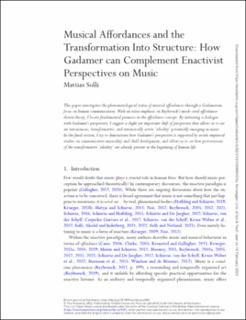| dc.contributor.author | Solli, Mattias | |
| dc.date.accessioned | 2023-02-22T10:08:41Z | |
| dc.date.available | 2023-02-22T10:08:41Z | |
| dc.date.created | 2022-01-05T20:28:18Z | |
| dc.date.issued | 2022 | |
| dc.identifier.citation | British Journal of Aesthetics. 2022, 62 (3), 431-452. | en_US |
| dc.identifier.issn | 0007-0904 | |
| dc.identifier.uri | https://hdl.handle.net/11250/3053122 | |
| dc.description.abstract | This paper investigates the phenomenological status of musical afordances through a Gadamerian focus on human communication. With an extra emphasis on Reybrouck’s much-cited afordance-driven theory, I locate fundamental premises in the afordance concept. By initiating a dialogue with Gadamer’s perspective, I suggest a slight yet important shift of perspective that allows us to see an autonomous, transformative, and intrinsically active ‘ideality’ potentially emerging in music. In the fnal section, I try to demonstrate how Gadamer’s perspective is supported by recent empirical studies on communicative musicality and child development, and allows us to see how protoversions of the transformative ‘ideality’ are already present at the beginning of human life. | en_US |
| dc.description.abstract | Musical affordances and the transformation into structure: How Gadamer can complement enactivist perspectives on music | en_US |
| dc.description.abstract | This paper investigates the phenomenological status of musical affordances through a Gadamerian focus on human communication. With an extra emphasis on Reybrouck’s much-cited affordance-driven theory, I locate fundamental premises in the affordance concept. By initiating a dialogue with Gadamer’s perspective, I suggest a slight yet important shift of perspective that allows us to see an autonomous, transformative, and intrinsically active ‘ideality’ potentially emerging in music. In the final section, I try to demonstrate how Gadamer’s perspective is supported by recent empirical studies on communicative musicality and child development, and allows us to see how protoversions of the transformative ‘ideality’ are already present at the beginning of human life. | en_US |
| dc.language.iso | eng | en_US |
| dc.publisher | Oxford University Press | en_US |
| dc.rights | Navngivelse-Ikkekommersiell 4.0 Internasjonal | * |
| dc.rights.uri | http://creativecommons.org/licenses/by-nc/4.0/deed.no | * |
| dc.title | Musical affordances and the transformation into structure: How Gadamer can complement enactivist perspectives on music | en_US |
| dc.title.alternative | Musical affordances and the transformation into structure: How Gadamer can complement enactivist perspectives on music | en_US |
| dc.type | Peer reviewed | en_US |
| dc.type | Journal article | en_US |
| dc.description.version | publishedVersion | en_US |
| dc.source.pagenumber | 431-452 | en_US |
| dc.source.volume | 62 | en_US |
| dc.source.journal | British Journal of Aesthetics | en_US |
| dc.source.issue | 3 | en_US |
| dc.identifier.doi | 10.1093/aesthj/ayac002 | |
| dc.identifier.cristin | 1975492 | |
| cristin.ispublished | true | |
| cristin.fulltext | original | |
| cristin.qualitycode | 2 | |

